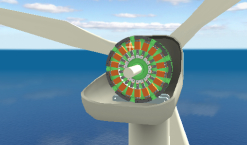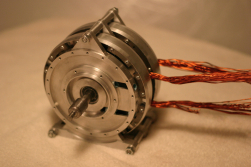
Efficiencies of Scale
By André Voshart
General Sustainability Energy sustainable design turbine WindUnique generator design looks to make wind turbines a more efficient and cost-effective power source.

A major drawback to wind energy is that typical generators operate at a steady speed regardless of how hard or softly the wind blows. When the shaft is turning at the optimal rate, more than 90 per cent of its energy can be converted into electricity; however, if it speeds up or slows down, efficiency drops precipitously.
This isn’t a problem in conventional power plants, where the turbines turn at a steady rate, fed by a constant supply of energy from coal or other fuels.
Wind speed, conversely, is inconsistent. If the wind blows too softly, a heavy gearbox is needed to translate the slow speed of the blades into a faster speed the traditional generator is designed for. If it blows too hard, the turbine must shed excess energy so as to avoid damaging the gearbox and other parts of the turbine.
To overcome this deficiency, Vancouver’s ExRo Technologies Inc. CTO Jonathan Ritchey has devised the Variable Input Electrical Generator, or VIEG (“veej”), optimized to handle the variable input speeds common to wind power.
“This is the renewable energy age,” he says, “and everyone is looking for the next big thing.” Founded in 2005, the company has 10 employees and a number of outside collaborators honing the design of his “next big thing.”

A Self-Adapting System
Basically, the VIEG works on the same principles as traditional generators: magnets attached to a rotating shaft create a current as they pass stationary copper coils arrayed around the shaft. However, the VEIG uses modular coil and magnet sets or stages that automatically turn on or off depending on wind speed.
With 12 years of Ritchey’s own research behind it, the VIEG doesn’t depend on a gearbox’s mechanical transmission. Instead, it’s built with an internal electronic controller that matches generator resistance to the wind energy available by turning stages on or off. Essentially, the VIEG adapts to the wind rather than forcing the shaft speed to adapt to the needs of the generator.
“The controller senses the available energy and output in real time and uses high-speed electronic switching to alter output and resistance,” Ritchey explains.
The result, he says, is a self-adapting system with a lower cost and weight and a broader operational range than traditional generators. “With the VEIG, we’re able to extract more energy by dynamically right-sizing the generator to the wind thereby operating at close to peak efficiency at all times.”
Ed Nowicki, an associate professor in the Department Electrical and Computer Engineering at the University of Calgary, who has consulted with ExRo, says there are other wind generator systems that reconnect to a different size generator as the wind speed changes. “The VEIG,” he counters, “is unique in that it effectively changes its size (by engaging only as many generation coils as needed) without the need to switch over to another generator shaft.”
Stacked in its Favour
Without the need for additional shafts, mechanical gears or clutches, Ritchey says ExRo keeps costs down by reducing the size and weight of the overall system.
The VEIG’s upgradeability also helps lower costs. As it stands, to upgrade the capacity of a traditional turbine, the most common option has been to expand the diameter of its generator, but this increases the torque necessary to move the rotors. With ExRo’s modular design, increasing capacity is simply a matter of installing additional stages.
“For example, if we made each stage 5 kW and just added stages (to 10 kW, 15 kW and so on), we could create a multitude of different-sized machines with virtually the same manufacturing components,” he says. “This gives us adaptability from a design perspective, and we can customize depending on the application.”
Another benefit is the ability to assemble the VIEG a stage at a time, on site. This reduces construction costs and complexity, and also allows repair crews to replace a single stage rather than remove the entire generator.

When looking at reductions in energy loss, Ritchey claims the company’s generator can help pull “a double-digit percent increase in efficiency” over traditional systems. And these estimates aren’t pulled from thin air: ExRo has developed and tested a lab-scale 1-kW prototype with 54 independent coils. By late-spring 2009, it will begin field-testing an updated 5-kW VIEG in a complete wind turbine system. He says the company won’t have firm power-production figures until those tests are complete, so he does not want to get too specific until then.
While the current focus has been on wind applications, “there are also significant opportunities for this technology in non-renewable markets,” he says, revealing that the company expects to team with manufacturers and start turning out portable gas powered generators in 2010, with small wind VIEGs shortly after that. Big wind applications could take until 2011. “It isn’t a huge undertaking to develop the VIEG for portable generators,” he says. “Then we’d put the money toward designing for other renewable applications.”
The Economic Argument
Wind energy represents a growth opportunity for companies like ExRo. Entering the New Year, Canada had 85 wind farms representing 2,246 MW of generating capacity. The Canadian Wind Energy Association (CanWEA) believes Canada can (and must) reach its target of producing 20 percent or more of the country’s electricity from wind by 2025.
This, Ritchey says, is possible, but it won’t happen out of the goodness of the investors’ or developers’ hearts given renewable energy is more costly than other less eco-friendly sources. “Our mandate as a company is ‘Cheaper than coal,’ ” he says. “If it’s a better economic plan to put in renewable energy, then they’ll make the decision.”
Nowicki agrees: “I find such innovations very exciting and very necessary to achieve the improvements in alternative energy sources that will make them … more attractive as replacements for conventional fossil-fuel-based energy sources.”
And there is money to be made, too. CanWEA announced that by 2020, close to US$1 trillion in investment is projected to bring global capacity to 500,000 MW.
“The bottom line is that it’s about money,” Ritchey adds. “We need to make renewable energy the best economic decision, and we see ourselves having a material role in making that happen.”
